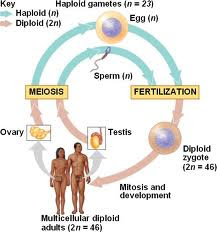Definition: Sexual reproduction is a process that creates a new organism by combining the genetic material of two organisms; it occurs both in eukaryotes and in prokaryotes. A key similarity between bacterial sex (bacterial conjugation) and eukaryotic sex is that DNA originating from two different individuals (parents) join up so that homologous sequences are aligned with each other, and this is followed by exchange of genetic information (a process called genetic recombination). After the new recombinant chromosome is formed, it is passed on to progeny).
On the other hand, bacterial conjugation, a type of transfer of DNA between two bacteria, is often regarded as equivalent of sexual reproduction because the mechanics are similar. This is because bacterial conjugation is controlled by plasmid genes that are adapted for spreading copies of the plasmid between bacteria. The infrequent integration of a plasmid into a host bacterial chromosome, and the subsequent transfer of a part of the host chromosome to another cell do not appear to be bacterial adaptations.
In contrast, bacterial transformation can be regarded as a form of sex in bacteria. Bacterial transformation is a complex process encoded by numerous bacterial genes, and is clearly a bacterial adaptation for DNA transfer. This process occurs naturally in at least 40 bacterial species. For a bacterium to bind, take up, and recombine exogenous DNA into its chromosome, it must enter a special physiological state referred to as competence (see Natural competence). Sexual reproduction in early single-celled eukaryotes may have evolved from bacterial transformation.
Sexual reproduction is the primary method of reproduction for the vast majority of macroscopic organisms, including almost all animals and plants. The evolution of sexual reproduction is a major puzzle. The first fossilized evidence of sexual reproduction in organisms such as eukaryotes is in the Stenian period, about 1 to 1.2 billion years ago. There are two main processes during sexual reproduction in eukaryotes: meiosis, involving the halving of the number of chromosomes; and fertilization, involving the fusion of two gametes and the restoration of the original number of chromosomes. During meiosis, the chromosomes of each pair usually cross over to achieve homologous recombination. Evolutionary thought proposes several explanations for why sexual reproduction developed and why it is maintained. These reasons include fighting the accumulation of deleterious mutations, increasing rate of adaptation to changing environments (see the red queen hypothesis), dealing with competition (see the tangled bank hypothesis) or as an adaptation for repairing DNA damage. The maintenance of sexual reproduction has been explained by theories that work at several different levels of selection, though some of these models remain controversial. New models presented in recent years, however, suggest a basic advantage for sexual reproduction in slowly reproducing, complex organisms, exhibiting characteristics that depend on the specific environment that the given species inhabit, and the particular survival strategies that they employ.


No comments:
Post a Comment